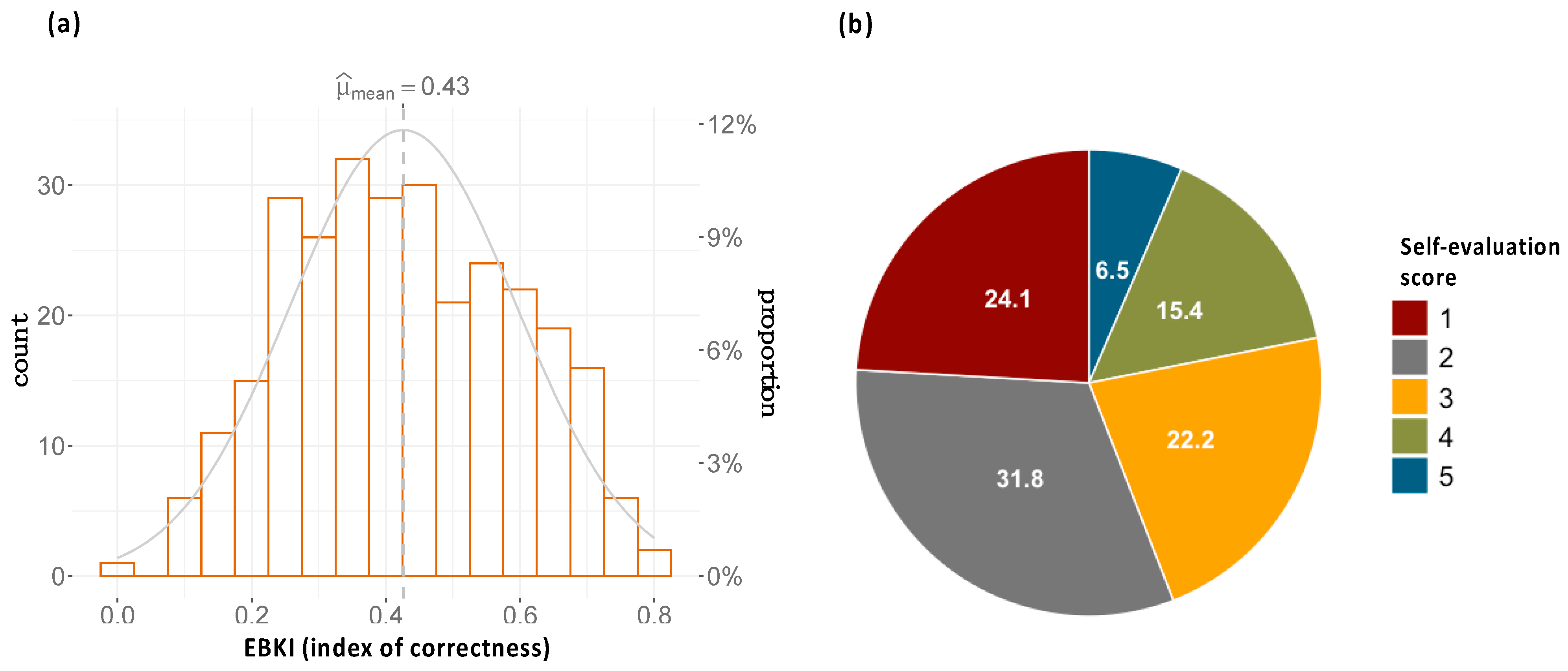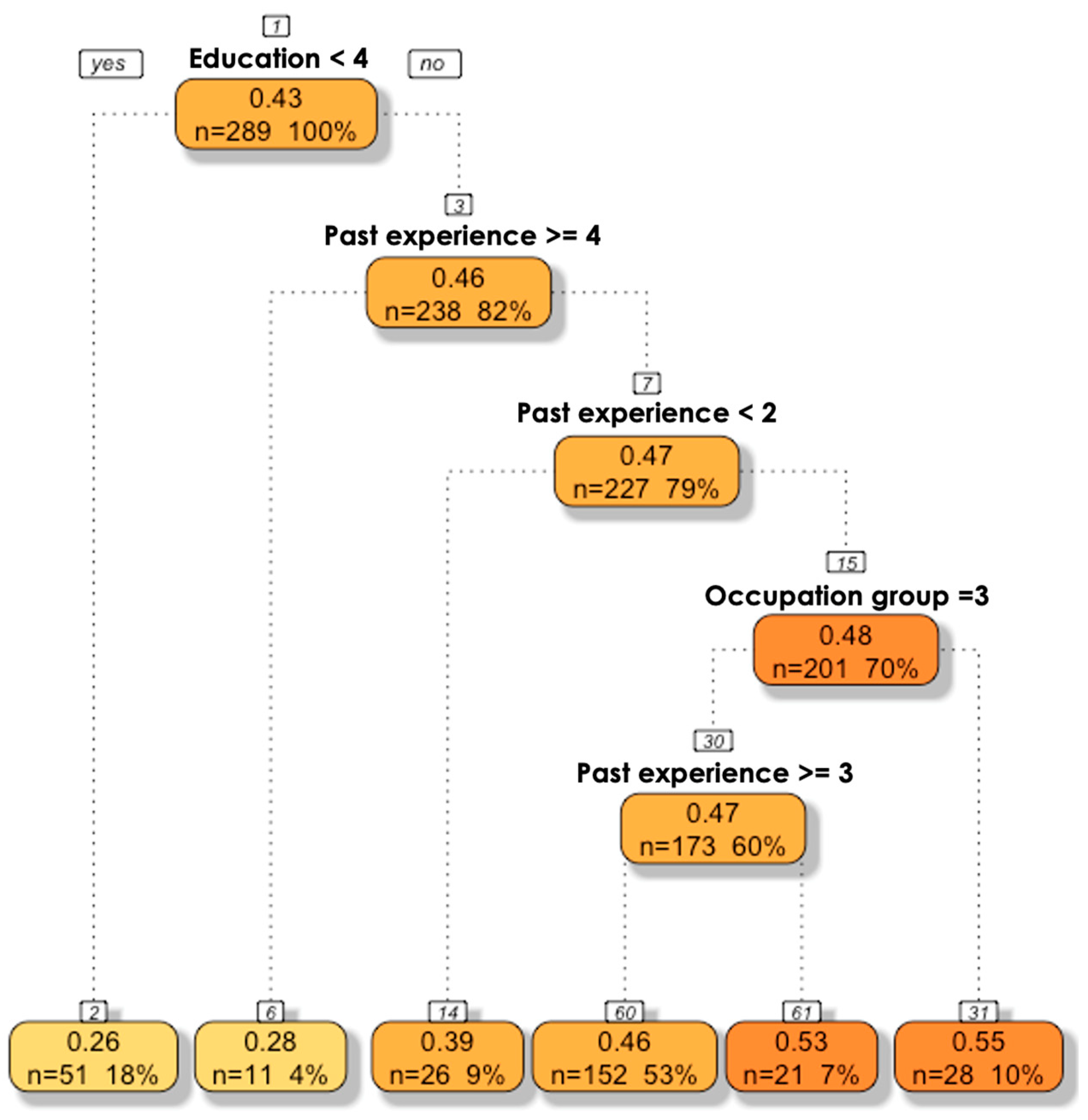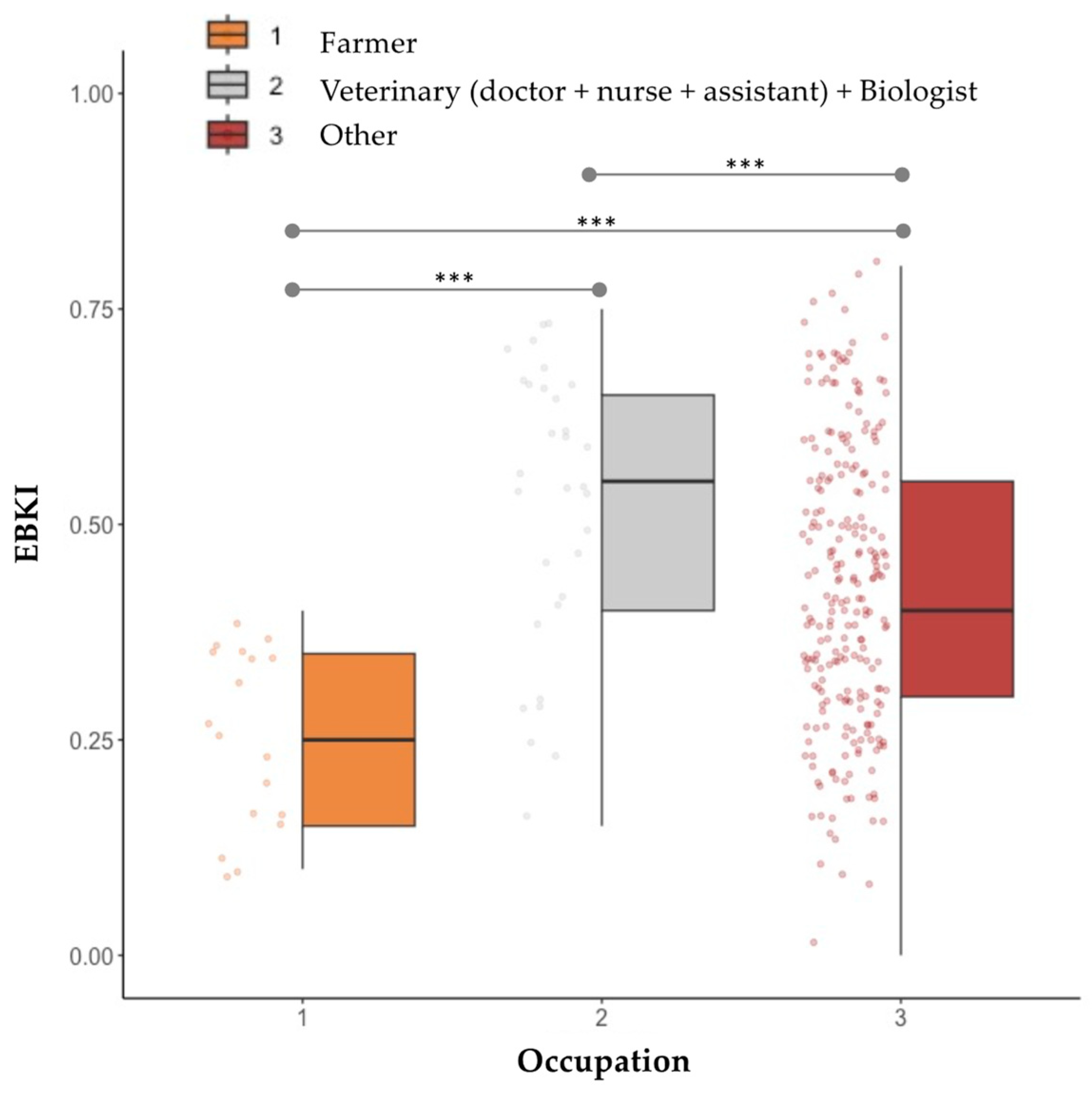Prickly Connections: Sociodemographic Factors Shaping Attitudes, Perception and Biological Knowledge about the European Hedgehog
Abstract
:Simple Summary
Abstract
1. Introduction
“We are human in good part because of the particular way we affiliate with other organisms”.E. O. Wilson. 1984. Biophilia—the human bond with other species, page 139.
2. Materials and Methods
2.1. Data Collection: Questionnaire Design and Survey
2.2. Feelings, Attitudes Towards, and Perceptions about Hedgehogs
2.3. Biological Knowledge about Hedgehogs
2.4. Self-Evaluation and Past Experience with the Species
2.5. Predictors of Attitudes, Perceptions, and Natural History Knowledge about Hedgehog
2.6. Data Analysis
3. Results
3.1. Socio-Demographic Features of Respondents
3.2. Feeling, Attitude and Perception Regarding Hedgehogs
3.3. Common Knowledge about Hedgehog Biology and Conservation
3.4. Self-Knowledge and Past Experience
3.5. Citizen Profile as a Driver of Attitudes, Perceptions and Common Knowledge
4. Discussion
4.1. Citizen Profile
4.2. Opportunities for Reconnecting with Nature—Education
4.3. Implications for Conservation Strategies and Eco-Schemes
4.4. Study Caveats
5. Conclusions
Supplementary Materials
Author Contributions
Funding
Institutional Review Board Statement
Informed Consent Statement
Data Availability Statement
Acknowledgments
Conflicts of Interest
References
- Pyle, R.M. The Thunder Tree; Houghton Mifflin: Boston, MA, USA, 1993. [Google Scholar]
- Miller, J.R. Biodiversity Conservation and the Extinction of Experience. Trends Ecol. Evol. 2005, 20, 430–434. [Google Scholar] [CrossRef]
- Soga, M.; Gaston, K.J. Extinction of Experience: The Loss of Human–Nature Interactions. Front. Ecol. Environ. 2016, 14, 94–101. [Google Scholar] [CrossRef]
- Kellert, S.R.; Wilson, E.O. The Biophilia Hypothesis; Island Press: Washington, DC, USA, 1993; ISBN 1559631473. [Google Scholar]
- Wilson, E.O. Biophilia; Harvard University Press: Cambridge, MA, USA, 1986; ISBN 0674268393. [Google Scholar]
- Hartig, T.; Mitchell, R.; de Vries, S.; Frumkin, H. Nature and Health. Annu. Rev. Public Health 2014, 35, 207–228. [Google Scholar] [CrossRef] [PubMed]
- White, M.P.; Elliott, L.R.; Grellier, J.; Economou, T.; Bell, S.; Bratman, G.N.; Cirach, M.; Gascon, M.; Lima, M.L.; Lõhmus, M.; et al. Associations between Green/Blue Spaces and Mental Health across 18 Countries. Sci. Rep. 2021, 11, 8903. [Google Scholar] [CrossRef] [PubMed]
- Otto, S.; Pensini, P. Nature-Based Environmental Education of Children: Environmental Knowledge and Connectedness to Nature, Together, Are Related to Ecological Behaviour. Glob. Environ. Chang. 2017, 47, 88–94. [Google Scholar] [CrossRef]
- Zaradic, P.A.; Pergams, O.R.W.; Kareiva, P. The Impact of Nature Experience on Willingness to Support Conservation. PLoS ONE 2009, 4, e7367. [Google Scholar] [CrossRef]
- Dickman, A.J. Complexities of Conflict: The Importance of Considering Social Factors for Effectively Resolving Human–Wildlife Conflict. Anim. Conserv. 2010, 13, 458–466. [Google Scholar] [CrossRef]
- Šūmane, S.; Kunda, I.; Knickel, K.; Strauss, A.; Tisenkopfs, T.; Rios, I.d.I.; Rivera, M.; Chebach, T.; Ashkenazy, A. Local and Farmers’ Knowledge Matters! How Integrating Informal and Formal Knowledge Enhances Sustainable and Resilient Agriculture. J. Rural Stud. 2018, 59, 232–241. [Google Scholar] [CrossRef]
- Castillo-Huitrón, N.M.; Naranjo, E.J.; Santos-Fita, D.; Estrada-Lugo, E. The Importance of Human Emotions for Wildlife Conservation. Front. Psychol. 2020, 11, 1277. [Google Scholar] [CrossRef] [PubMed]
- Rosa, C.D.; Collado, S. Experiences in Nature and Environmental Attitudes and Behaviors: Setting the Ground for Future Research. Front. Psychol. 2019, 10, 763. [Google Scholar] [CrossRef]
- Soga, M.; Gaston, K.J. The Ecology of Human–Nature Interactions. Proc. R. Soc. B 2020, 287, 20191882. [Google Scholar] [CrossRef] [PubMed]
- Straka, T.M.; Miller, K.K.; Jacobs, M.H. Understanding the Acceptability of Wolf Management Actions: Roles of Cognition and Emotion. Hum. Dimens. Wildl. 2020, 25, 33–46. [Google Scholar] [CrossRef]
- Ceríaco, L.M.; Marques, M.P.; Madeira, N.C.; Vila-Viçosa, C.M.; Mendes, P. Folklore and Traditional Ecological Knowledge of Geckos in Southern Portugal: Implications for Conservation and Science. J. Ethnobiol. Ethnomedicine 2011, 7, 26. [Google Scholar] [CrossRef]
- Manfredo, M.J. Who Cares About Wildlife? Springer: Berlin/Heidelberg, Germany, 2008; pp. 1–27. [Google Scholar] [CrossRef]
- Ives, C.D.; Lentini, P.E.; Threlfall, C.G.; Ikin, K.; Shanahan, D.F.; Garrard, G.E.; Bekessy, S.A.; Fuller, R.A.; Mumaw, L.; Rayner, L.; et al. Cities Are Hotspots for Threatened Species: The Importance of Cities for Threatened Species. Glob. Ecol. Biogeogr. 2015, 25, 117–126. [Google Scholar] [CrossRef]
- Alagona, P.S. The Accidental Ecosystem: People and Wildlife in American Cities; University of California Press: Berkeley, CA, USA, 2022. [Google Scholar]
- Hubert, P.; Julliard, R.; Biagianti, S.; Poulle, M.-L. Ecological Factors Driving the Higher Hedgehog (Erinaceus Europeaus) Density in an Urban Area Compared to the Adjacent Rural Area. Landsc. Urban Plan. 2011, 103, 34–43. [Google Scholar] [CrossRef]
- Amori, G. Erinaceus Europaeus. The IUCN Red List of Threatened Species; IUCN: Gland, Switzerland, 2016; e.T29650A2791303. [Google Scholar]
- Mathias, M.d.L.; Fonseca, C.; Rodrigues, L.; Grilo, C.; Lopes-Fernandes, M.; Palmeirim, J.M.; Santos-Reis, M.; Alves, P.C.; Cabral, J.A.; Ferreira, M. Livro Vermelho Dos Mamíferos de Portugal Continental; Fciências, I.D., Ed.; ICNF: Lisboa, Portugal, 2023; ISBN 9895372426. [Google Scholar]
- Hof, A.R.; Bright, P.W. Quantifying the Long-Term Decline of the West European Hedgehog in England by Subsampling Citizen-Science Datasets. Eur. J. Wildl. Res. 2016, 62, 407–413. [Google Scholar] [CrossRef]
- Pettett, C.E.; Johnson, P.J.; Moorhouse, T.P.; Macdonald, D.W. National Predictors of Hedgehog Erinaceus Europaeus Distribution and Decline in Britain. Mammal Rev. 2018, 48, 1–6. [Google Scholar] [CrossRef]
- Taucher, A.L.; Gloor, S.; Dietrich, A.; Geiger, M.; Hegglin, D.; Bontadina, F. Decline in Distribution and Abundance: Urban Hedgehogs under Pressure. Animals 2020, 10, 1606. [Google Scholar] [CrossRef] [PubMed]
- Dowding, C.V.; Shore, R.F.; Worgan, A.; Baker, P.J.; Harris, S. Accumulation of Anticoagulant Rodenticides in a Non-Target Insectivore, the European Hedgehog (Erinaceus Europaeus). Environ. Pollut. 2010, 158, 161–166. [Google Scholar] [CrossRef]
- Moore, L.J.; Petrovan, S.O.; Baker, P.J.; Bates, A.J.; Hicks, H.L.; Perkins, S.E.; Yarnell, R.W. Impacts and Potential Mitigation of Road Mortality for Hedgehogs in Europe. Animals 2020, 10, 1523. [Google Scholar] [CrossRef] [PubMed]
- Pettett, C.E.; Moorhouse, T.P.; Johnson, P.J.; Macdonald, D.W. Factors Affecting Hedgehog (Erinaceus Europaeus) Attraction to Rural Villages in Arable Landscapes. Eur. J. Wildl. Res. 2017, 63, 54. [Google Scholar] [CrossRef]
- Jota Baptista, C.; Seixas, F.; Gonzalo-Orden, J.M.; Patinha, C.; Pato, P.; Ferreira da Silva, E.; Casero, M.; Brazio, E.; Brandão, R.; Costa, D.; et al. High Levels of Heavy Metal(loid)s Related to Biliary Hyperplasia in Hedgehogs (Erinaceus europaeus). Animals 2023, 13, 1359. [Google Scholar] [CrossRef]
- Ruszkowski, J.J.; Hetman, M.; Turlewicz-Podbielska, H.; Pomorska-Mól, M. Hedgehogs as a Potential Source of Zoonotic Pathogens-A Review and an Update of Knowledge. Animals 2021, 11, 1754. [Google Scholar] [CrossRef]
- Jota Baptista, C.; Oliveira, P.A.; Gonzalo-Orden, J.M.; Seixas, F. Do Urban Hedgehogs (Erinaceus europaeus) Represent a Relevant Source of Zoonotic Diseases? Pathogens 2023, 12, 268. [Google Scholar] [CrossRef] [PubMed]
- Pe’er, G.; Finn, J.A.; Díaz, M.; Birkenstock, M.; Lakner, S.; Röder, N.; Kazakova, Y.; Šumrada, T.; Bezák, P.; Concepción, E.D.; et al. How Can the European Common Agricultural Policy Help Halt Biodiversity Loss? Recommendations by over 300 Experts. Conserv. Lett. 2022, 15, e12901. [Google Scholar] [CrossRef]
- Aguiar, A.; Pinto, M.; Duarte, R. Psychological Impact of the COVID-19 Pandemic and Social Determinants on the Portuguese Population: Protocol for a Web-Based Cross-Sectional Study. JMIR Res. Protoc. 2021, 10, e28071. [Google Scholar] [CrossRef]
- Therneau, T.; Atkinson, B. _rpart: Recursive Partitioning and Regression Trees_. Rpackage version 4.1.19. 2022. Available online: https://CRAN.R-project.org/package=rpart (accessed on 15 September 2023).
- Milborrow, S. _rpart.plot: Plot ‘rpart’ Models: An Enhanced Version of ‘plot.rpart’_. R package version 3.1.1. 2022. Available online: https://CRAN.R-project.org/package=rpart.plot (accessed on 15 September 2023).
- Breiman, L. Classification And Regression Trees; Routledge: New York, NY, USA, 2022. [Google Scholar] [CrossRef]
- Jordan, N.R.; Smith, B.P.; Appleby, R.G.; Eeden, L.M.; Webster, H.S. Addressing Inequality and Intolerance in Human–Wildlife Coexistence. Conserv. Biol. 2020, 34, 803–810. [Google Scholar] [CrossRef] [PubMed]
- Barradas, P.F.; Mesquita, J.R.; Mateus, T.L.; Ferreira, P.; Amorim, I.; Gärtner, F.; Sousa, R. de Molecular Detection of Rickettsia Spp. in Ticks and Fleas Collected from Rescued Hedgehogs (Erinaceus Europaeus) in Portugal. Exp. Appl. Acarol. 2021, 83, 449–460. [Google Scholar] [CrossRef] [PubMed]
- Yarnell, R.W.; Pettett, C.E. Beneficial Land Management for Hedgehogs (Erinaceus Europaeus) in the United Kingdom. Animals 2020, 10, 1566. [Google Scholar] [CrossRef] [PubMed]
- Kusmanoff, A.M.; Fidler, F.; Gordon, A.; Garrard, G.E.; Bekessy, S.A. Five Lessons to Guide More Effective Biodiversity Conservation Message Framing. Conserv. Biol. 2020, 34, 1131–1141. [Google Scholar] [CrossRef]
- Massfeller, A.; Meraner, M.; Hüttel, S.; Uehleke, R. Farmers’ Acceptance of Results-Based Agri-Environmental Schemes: A German Perspective. Land Polic. 2022, 120, 106281. [Google Scholar] [CrossRef]
- Bennett, N.J.; Roth, R.; Klain, S.C.; Chan, K.; Christie, P.; Clark, D.A.; Cullman, G.; Curran, D.; Durbin, T.J.; Epstein, G.; et al. Conservation Social Science: Understanding and Integrating Human Dimensions to Improve Conservation. Biol. Conserv. 2017, 205, 93–108. [Google Scholar] [CrossRef]
- Tourangeau, R.; Rips, L.J.; Rasinski, K. The Psychology of Survey Response; Cambridge University Press: Cambridge, UK, 2000. [Google Scholar] [CrossRef]
- INE—National Statistics Institute. Available online: https://censos.ine.pt (accessed on 15 September 2023).
- FFMS—Fundação Francisco Manuel dos Santos. Available online: https://www.pordata.pt/en (accessed on 15 September 2023).



| Attitude | Perception | |||
|---|---|---|---|---|
| Explanatory | Towards a Hedgehog in Difficulties | Management/Conservation Measures | Human Effect on Mortality | Hedgehog Impact on Farming |
| Gender | χ2 = 10.19 p = 0.25 VCramer = 0.06 | χ2 = 0.49 p = 0.97 VCramer = 0.00 | χ2 = 4.38 p = 0.93 VCramer = 0.00 | χ2 = 6.85 p = 0.74 VCramer = 0.00 |
| Level of urbanization | χ2 = 5.77 p = 0.67 VCramer = 0.00 | χ2 = 2.26 p = 0.69 VCramer = 0.00 | χ2 = 10.94 p = 0.36 VCramer = 0.04 | χ2 = 6.51 p = 0.85 VCramer = 0.00 |
| Academic qualification | χ2 = 171.56 p = 1.43 × 10−22 VCramer = 0.35 | χ2 = 78.19 p = 6.12 × 10−11 VCramer = 0.33 | χ2 = 153.08 p = 1.03 × 10−18 VCramer = 0.29 | χ2 = 72.11 p = 2.23 × 10−4 VCramer = 0.16 |
| Occupation | χ2 = 77.82 p = 1.34 × 10−13 VCramer = 0.35 | χ2 = 41.95 p = 1.71 × 10−8 VCramer = 0.26 | χ2 = 70.39 p = 3.72 × 10−11 VCramer = 0.32 | χ2 = 14.47 p = 0.15 VCramer = 0.09 |
| Past experience | χ2 = 43.20 p = 2.61 × 10−4 VCramer = 0.15 | χ2 = 16.71 p = 0.03 VCramer = 0.12 | χ2 = 25.40 p = 0.19 VCramer = 0.07 | χ2 = 39.32 p = 6.08 × 10−3 VCramer = 0.13 |
Disclaimer/Publisher’s Note: The statements, opinions and data contained in all publications are solely those of the individual author(s) and contributor(s) and not of MDPI and/or the editor(s). MDPI and/or the editor(s) disclaim responsibility for any injury to people or property resulting from any ideas, methods, instructions or products referred to in the content. |
© 2023 by the authors. Licensee MDPI, Basel, Switzerland. This article is an open access article distributed under the terms and conditions of the Creative Commons Attribution (CC BY) license (https://creativecommons.org/licenses/by/4.0/).
Share and Cite
Ribeiro, Â.M.; Rodrigues, M.; Brito, N.V.; Mateus, T.L. Prickly Connections: Sociodemographic Factors Shaping Attitudes, Perception and Biological Knowledge about the European Hedgehog. Animals 2023, 13, 3610. https://doi.org/10.3390/ani13233610
Ribeiro ÂM, Rodrigues M, Brito NV, Mateus TL. Prickly Connections: Sociodemographic Factors Shaping Attitudes, Perception and Biological Knowledge about the European Hedgehog. Animals. 2023; 13(23):3610. https://doi.org/10.3390/ani13233610
Chicago/Turabian StyleRibeiro, Ângela M., Micaela Rodrigues, Nuno V. Brito, and Teresa Letra Mateus. 2023. "Prickly Connections: Sociodemographic Factors Shaping Attitudes, Perception and Biological Knowledge about the European Hedgehog" Animals 13, no. 23: 3610. https://doi.org/10.3390/ani13233610
APA StyleRibeiro, Â. M., Rodrigues, M., Brito, N. V., & Mateus, T. L. (2023). Prickly Connections: Sociodemographic Factors Shaping Attitudes, Perception and Biological Knowledge about the European Hedgehog. Animals, 13(23), 3610. https://doi.org/10.3390/ani13233610






